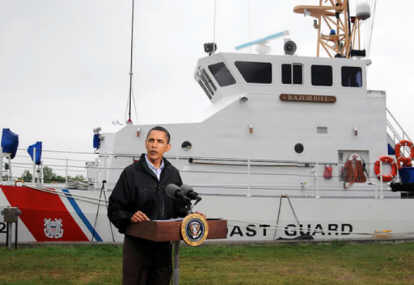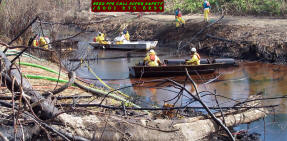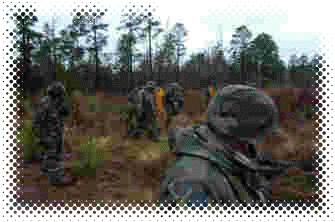|
We take government credit cards.
This training considers the special needs of all occupations who work in
such events as a Disaster.
We recommend HAZWOPER training for all Clean-up workers
40 Hour HAZWOPER
We recommend only personnel with 24 Hour HAZWOPER (area
below the PEL) 40 HAZWOPER (above the Permissible Exposure
Limits or potential; people
engage in oil spill
recovery operations
spraying oil off booms and collecting contaminated booms
with oil (PHOTOS). 40 Hour training teaches
workers why and how to avoid contact and the importance of
avoiding breathing oil contaminated mist or black oil smoke.
CURRENT NEWS ON THIS INCIDENT PLEASE RETURN
GULF SPILL NEWS
CONTACT OUR REPRESENTATIVE FOR DETAILS.
Disaster Recovery
Planning and Continuity Plans Click Here!
Disaster safety
equipment products see
http://www.supersafety.com
Tell us what training you need or what you want to order.
Telephone us call (800) 275-8239 or FAX
773-538-8080
Contact Us.
INTERNATIONAL CALL COUNTRY CODE +1 (312) 543-6742
or
INTERNATIONAL FAX 001 or +1 773-538-8080
OSHA Disaster Site Worker (DSW) training states disasters
start and end in the community where the DSW will work.
This training program deploys the latest technology and
human resources to work safely at Disaster Sites and to help
the victims recover at the community where the disaster
begins and ends.
Call us at (800) 275-8239 to discuss what options we can
provide to help you best utilize your security, emergency
preparedness or disaster preparedness financial resources.
If your a Site Supervisor or Site Safety Officer you may
want to look at this link. Come back please.

We have a long way to go to truly be prepared for another
major disaster like Hurricane Katrina. It takes
environmental specialist and
construction workers with DSW or equivalent training.
It's work in this day and age that those type of companies
do that help America recover. Those companies need to
have many business items in place before putting workers in
the field to be certified a DSW such as training, funding
and basic survival such as food and lodging. During
times when those services are not needed budgets are
stretched thin there are pre-disaster reductions in force
and equipment has to be maintained or purchased. It
takes time to mobilize all of this and the Private Sector
simply can't afford to keep on staff equipment and personnel
so when a disaster happens it often will take time to ensure
funds are there to do the work. We realize that the
disaster site workers need good training and a sharp
awareness of teamwork, construction techniques, Weapons of
Mass Destruction (WMD) awareness and their role reporting to
their line Supervisor to stay safe.
Our mission is to provide professional DSW short 16 hour
courses getting employee's ready to do the work to assist
those in need for humanitarian relief, assisting other
federal agencies, and protecting the environment.
We do this by training the DSW to: Report to their
Supervisor, All types of Hazard Recognition, Use
Professional Judgment, Deal with Chemical, Biohazards, WMD,
in construction safety, and HAZWOPER skills or Disaster Site
Worker training.
If you are a company we can train you so that you can
understand the business or your clients. If you are an
individual call we will train you, the training is valuable.
We are not an employment agency or school with a placement
service. We provide short professional courses like
the Disaster Site Worker course which is not OSHA mandated.
The Hazardous Waste and Emergency Response Course is OSHA
mandated for working while employed with Dangerous
Chemicals, Fire, Explosions that could because of
possibility of serious injury or death. Hurricane
Katrina for example is a National Disaster not regulated by
OSHA until it is downgraded then OSHA has authority.
In addition, the
http://www.niehs.nih.gov/ is reaching out to this sector
in construction and OSHA and others to get more people
involved with the Disaster Site Work Program. For more
information on sharing your funding with us at Chicago
Safety Institute or NIEHS.
Furthermore, OSHA has taken a new position recommending now
DSW training allows issuing a Disaster Site Worker
Certification after an
OSHA 10 Hour
Class for construction.
In addition, we have established an effective national
framework to develop and provide comprehensive training that
is needed to address Superfund cleanups, chemical emergency
responses, RCRA corrective actions, and environmental
restoration in urban communities surrounding Brownfield's
sites.
Funding and charities must be available to bring in help
from the public sector or private sector when the
infrastructure is destroyed (the
basic facilities, services, and installations needed for the
functioning of a community or society, such as
transportation and communications systems, water and power
lines, and public institutions including schools, post
offices, and prisons).
Disaster Site Worker
The pre-requisite is that the worker must
have
OSHA Ten Hour training
and be medically qualified to wear a respirator. This is a
two day, Instructors Approved By OSHA Train The Trainer,
performance based training not available online, trainees must
demonstrate to an instructor their skills as specified in
disaster recovery techniques, knowledge of chemical hazards,
Biohazards, Weapons Of Mass Destruction (WMD), Air-Purifying
respirator training and OSHA recommended curriculum, and
interpretations. It includes many things that are related
to disasters that can fall anywhere at anytime, we do not
currently advise or endorse any online training for
Disaster Site
Workers.
This program is a pre-requisite for "The OSHA Program Card".
Why do workers need this
training like the OSHA Program Card the chemical side of
disasters? It is now the trend of the response industry for
specialization and qualifying employees.
Can you name some types of Disasters?
We can and will go through it all, even
Katrina! BP Oil SPill Macando 252 Deepwater Horizon, Hurricane Charlie is a Disaster, so was the World trade
Tower attack, the anthrax terrorism, Times Beach, Mo., The
Chicago Fire and many more. Do you know what a TIC is?
Participants learn about hazards, to operate under the latest
and greatest Incident Command System and their supervisor.
They also learn how to deal with trauma types of events.
Some of these events such as Earthquakes, floods, Energetic or
explosions often destroy building or infrastructure and large
numbers of craftsmen and trades have to work on the Disaster.
For example road repair where and the Department of
Transportation (DOT) has to deal with the matter by having
workers repair the damage. Their is much more call today our
representative will explain and provide you with the information
you need to take the training.
 With US Coast Guard Cutter
With US Coast Guard Cutter
MAP OF
EMERGENCY RESPONSE GULF DEEPWATER HORIZON INCIDENT HOT ZONE
 
Although some training is
primarily classroom based, class room training is conducted with
information with a live instructor.
Notes are prepared to assist in the educational process.
All trainees get in addition
to training a CD with Disaster Site Guidance for each participant
and other resources for each trainees toolbox of written resources.
More importantly trainees learn how to have a community
Disaster Site recover from the damage and terrible event. Of
course it includes methods terrorist have been known to use and
current related events. Chemical, Biological, Radiological and
Nuclear (CBRN) emergency response training is also overviewed,
special training can include response, awareness of the hazards of
Anthrax and other Biological agents. Radiation hazard
awareness is covered. In addition, the elements of Personal
Protective Equipment (PPE), preparation for emergency disposal
considerations, decontamination of personnel and equipment. These
are customized for each group.
These individuals going through training are
evaluated in detail before proceeding to the next progression.
Each student receives a toolbox of resources and written material to
guide them through the levels.
The
course is taught in a friendly and comprehensive mannerism to make
learning fun and easy for the precipitants. If money is a
problem let us know how we can help! This is a great course!
Key
topics are taught 1,2,3.. by 1 Introduction, 2 Learn, 3 Apply &
Action.
This is a two
day course.
|

Hemphill, TX, February 5, 2003 -- National
Guard troops and
Texas Department of Public Safety Officers
search for shuttle material in the woods near Hemphill, TX . Photo
by Mark Wolfe/FEMA News Photo
|

New York, NY, September 14, 2001 --
President Bush addresses rescue workers at the site of the World
Trade Center disaster.
His message was one of encouragement for
the hundreds of rescue workers at the site. Photo by SFC Thomas
R. Roberts/ NGB-PASE
|
Please see our
schedule for details of getting the
Disaster Site Worker training.
What to do
if you are affected.
We also provide Site Safety
services as your Industrial Hygienist and Safety Management
Consultant. We assist in Disaster Recovery Services.
Our Audits prevent disaster from impacting business too.
We can show that using our services is cheaper than using
alternatives. Call us before the Disaster if you have a
disaster get help from us or one of our clients companies.
Our Network of Client Companies are all specialists in many
areas and disciplines that are necessary for Disaster Recovery.
Other information
Marine Spill
Spill Prevention Planning
Incident Command
Oil Effects Marine and Wetlands
Oil Shoreline Assessment and Clean Up
Dispersants
In Situ Burning
Mechanical Containment and Recovery
The Regulations and
USCG in part only this many has several other parts.
Private Sector
DHS and NRP primary and support agencies coordinate with the
private sector to effectively share information, form courses of
action, and incorporate available resources to prevent, prepare
for, respond to, and recover from Incidents of National
Significance. Further, the Secretary of Homeland Security
utilizes a private-sector advisory group with broad
representation to provide advice on incident management and
emergency response issues impacting their stakeholders.
Roles:
The roles,
responsibilities, and participation of the private sector during
Incidents of National
Significance vary based on the nature of the organization and
the type and impact of the incident. The roles of private-sector
organizations are summarized below.
Impacted Organization or
Infrastructure
Private-sector organizations may
be affected by direct or indirect consequences of the incident,
including privately owned critical infrastructure, key
resources, and those main private-sector organizations that are
significant to local, regional, and national economic recovery
from the incident. Examples of privately owned infrastructure
include transportation, telecommunications, private utilities,
financial institutions, and hospitals.
Response Resource Private-sector organizations
provide response resources (donated or compensated) during an
incident—including specialized teams, equipment, and advanced
technologies —through local public-private emergency plans,
mutual aid agreements, or incident specific requests from
government and private-sector-volunteered initiatives.
Regulated and/or Responsible
Party
Owners/operators of certain
regulated facilities or hazardous operations may bear
responsibilities under the law for preparing for and preventing
incidents from occurring, and responding to an incident once it
occurs. For example, Federal regulations require
owners/operators of Nuclear Regulatory Commission
(NRC)-regulated nuclear facilities and activities to maintain
emergency (incident) preparedness plans, procedures, and
facilities and to perform assessments, prompt notifications, and
training for a response to an incident.
State/Local Emergency
Organization Member Private-sector organizations may
serve as an active partner in local and State emergency
preparedness and response organizations and activities.
Responsibilities:
Private-sector organizations support the
National Response Plan (NRP) (voluntarily or to comply with applicable laws and
regulations) by sharing information with the government,
identifying risks, performing vulnerability assessments,
developing emergency response and business continuity plans,
enhancing their overall readiness, implementing appropriate
prevention and protection programs, and donating or otherwise
providing goods and services through contractual arrangement or
government purchases to assist in response to and recovery from
an incident. Certain organizations are required by
existing law and regulation to bear the cost of planning and
response to incidents, regardless of cause. In the case of an
Incident of National Significance, these private-sector
organizations are expected to mobilize and employ the resources
necessary and available in accordance with their plans to
address the consequences of incidents at their own facilities or
incidents for which they are otherwise responsible.
Response Resources:
Unless the response role is inherently
governmental (e.g., law enforcement, etc.), private-sector
organizations are encouraged to develop and maintain
capabilities to respond to and manage a complete spectrum of
incidents and emergencies. The Federal Government maintains
ongoing interaction with the critical infrastructure and key
resources industries to provide coordination for prevention,
preparedness, response, and recovery activities. When practical,
or when required under Federal law, private-sector
representatives should be included in planning and exercises.
The government may, in some cases, direct private-sector
response resources when they have contractual relationships,
using government funds. Through the Defense Production Act
of 1950, 64 Stat.798 (1950), as amended, and the Homeland
Security Act, DHS has the authority to redirect production and
distribution of certain response and incident management
resources.
Functional Coordination:
The primary agency(ies) for each
ESF maintains working relations with its associated
private-sector counterparts through partnership committees or
other means (e.g., ESF #2, Communications – telecommunications
industry; ESF #10, Oil and Hazardous Materials Response – oil
and hazardous materials industries; etc.).
Citizen Involvement
Strong partnerships with citizen
groups and organizations provide support for incident management
prevention, preparedness, response, recovery, and mitigation.
The U.S. Citizen Corps brings these groups together and focuses
efforts of individuals through education, training, and
volunteer service to help make communities safer, stronger, and
better prepared to address the threats of terrorism, crime,
public health issues, and disasters of all kinds. Local
Citizen Corps Councils implement Citizen Corps programs, which
include Community Emergency Response Teams (CERTs), Medical
Reserve Corps, Neighborhood Watch, Volunteers in Police Service,
and the affiliate programs; provide opportunities for special
skills and interests; develop targeted outreach for
special-needs groups; and organize special projects and
community events. Citizen Corps Affiliate Programs expand
the resources and materials available to States and local
communities through partnerships with programs and organizations
that offer resources for public education, outreach, and
training; represent volunteers interested in helping to make
their communities safer; or offer volunteer service
opportunities to support first responders, disaster relief
activities, and community safety efforts. Other programs
unaffiliated with Citizen Corps also provide organized citizen
involvement opportunities in support of Federal response to
major disasters and events of national significance. One example
is the National Animal Health Emergency Response Corps (NAHERC),
which helps protect public health by providing a ready reserve
of private and State animal health technicians and veterinarians
to combat threats to U.S. livestock and poultry in the event of
a large outbreak of a foreign animal disease.
Citizen Corps:
The Citizen Corps works through a national
network of State, local, and tribal Citizen Corps Councils,
which bring together leaders from law enforcement, fire,
emergency medical and other emergency management, volunteer
organizations, local elected officials, the private sector, and
other community stakeholders.
 TOP TOP
|

 With US Coast Guard Cutter
With US Coast Guard Cutter



